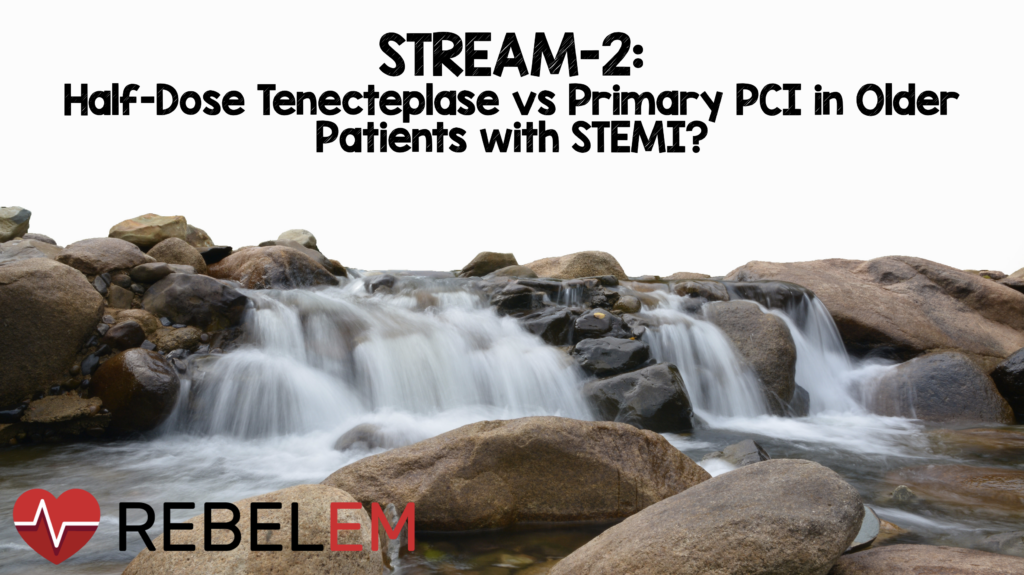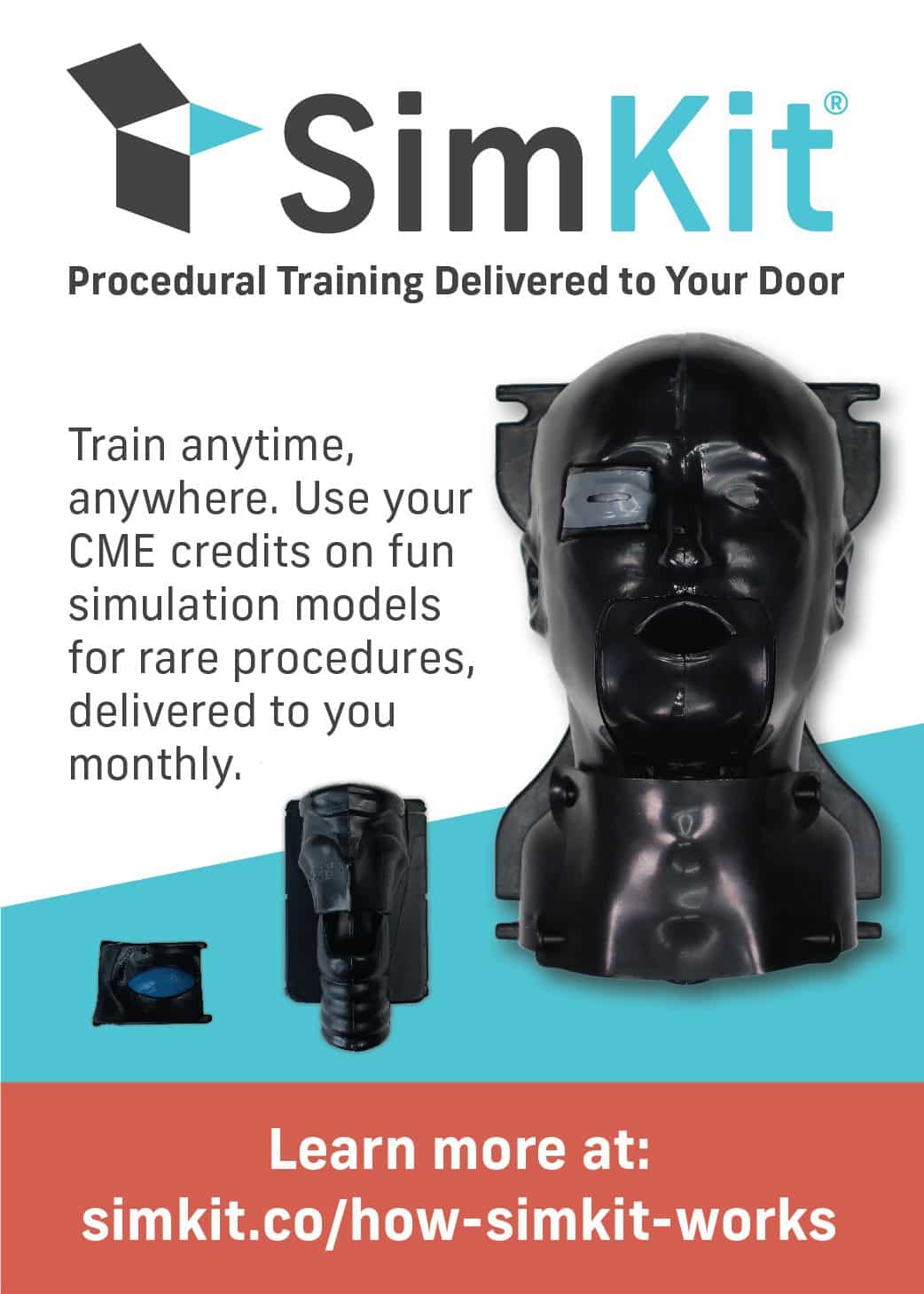 Background: Primary PCI is the recommended reperfusion strategy in patients with STEMI and should be initiated within 2 hours after first medical contact. In non-PCI-capable hospitals this goal is not always achievable due to delays in transfer. In these cases, thrombolysis is recommended to improve morbidity and mortality.
Background: Primary PCI is the recommended reperfusion strategy in patients with STEMI and should be initiated within 2 hours after first medical contact. In non-PCI-capable hospitals this goal is not always achievable due to delays in transfer. In these cases, thrombolysis is recommended to improve morbidity and mortality.
The STREAM-1 trial found that for [2] patients with STEMI presenting within 3 hours of symptom onset and unable to attain PCI within 1 hour of first medical contact, a pharmaco-invasive strategy resulted in similar rates of death, shock, heart failure, or reinfarction compared to primary PCI. The initial data demonstrated an excess of ICH in patients ≥75 years of age and prompted halving the dose of weight-adjusted tenecteplase with no subsequent ICH in the remaining 97 patients. Based on this, the authors did a literature review and found that there is an increasing rate of ICH and major non-intracranial bleeding starting at ≈60 years of age.
Paper: Van de Werf, F et al. STREAM-2: Half-Dose Tenecteplase or Primary Percutaneous Coronary Intervention in Older Patients With ST-Segment-Elevation Myocardial Infarction: A Randomized, Open-Label Trial. Circ 2023. PMID: 37439219
Clinical Question: Is half-dose tenecteplase an effective and safe pharmaco-invasive treatment in older patients with STEMI, presenting within 3 hours of symptom onset, and unable to undergo primary PCI within 1 hour compared to standard primary PCI?
What They Did:
- Strategic Reperfusion in Elderly Patients Early After Myocardial Infarction (STREAM-2)
- Investigator-initiated, open-label, prospective, randomized, multicenter trial
- Conducted in 49 centers in 10 countries
- Patients ≥60 years of age with ≥2mm STEMI in 2 contiguous leads, unable to undergo primary PCI within 1 hour sere randomly assigned (2:1) to:
- Pharmaco-Invasive Treatment: Half-Dose Tenecteplase followed by coronary angiography and PCI if indicated) 6 to 24 hours after randomization
- Tenecteplase Dosing:
- ≥55 to <60kg = 15mg
- ≥60 to <70kg = 17.5mg
- ≥70 to <80kg = 20mg
- ≥80 to <90kg = 22.5mg
- ≥90kg = 25mg
- Primary PCI
- Tenecteplase Dosing:
- Pharmaco-Invasive Treatment: Half-Dose Tenecteplase followed by coronary angiography and PCI if indicated) 6 to 24 hours after randomization
Outcomes:
- Primary:
- Reperfusion Efficacy: ST Segment Resolution ≥50% in the lead with worst ST-Segment Elevation
- Resolution of ST Deviations (in percentages and in millimeters) afger last angiography
- 30d Composite of Death, Shock, Heart Failure, or Reinfarction
- Safety:
- Stroke
- Non-Intracranial Bleeding
Inclusion:
- Original protocol included patients ≥70 years of age, but due to slow recruitment and amendment was made to include patients ≥60 years of age
- Patients weighed ≥55kg
- Presented within 3 hours after symptom onset
- EKG evidence of STEMI (ST-Segment Elevation of at least 2mm in 2 contiguous leads)
- Unable to undergo primary PCI within 1 hour but before 3 hours after first medical contact
Exclusion:
- Expected performance of PCI <60min from diagnosis (qualifying ECG) or inability to arrive at the catheterization lab within 3 hours
- Previous CABG
- LBBB or Ventricular Pacing
- Cardiogenic Shock (Killip Class IV)
- Body weight <55kg
- Uncontrolled HTN (sustained BP ≥180/110mmHg)
- Known prior stroke or TIA
- Recent administration of any IV or SC anticoagulation within 12 hours or current use of oral anticoagulation
- Active bleeding or known bleeding disorder/diathesis
- Known history of central nervous system damage (i.e. neoplasm, aneurysm, intracranial or spinal surgery) or recent trauma to head or cranium (i.e. <3 months)
- Major surgery, biopsy of a parenchymal organ or significant trauma within the past 2 months
- Clinical diagnosis associated with increased risk of bleeding including known active PUD and/or neoplasm with increased bleeding risk
- Known severe renal insufficiency
- Prolonged CPR (>2min) with past 2 weeks
- Known acute pericarditis and/0r subacute bacterial endocarditis
- Known acute pancreatitis or known severe hepatic dysfunction
- Dementia
- Previous enrollment in the study or treatment with an investigational drug./device under another study protocol within the past 7d
- Known allergic reactions to tenecteplase, clopidogrel, enoxaparin, and aspirin
- Inability to follow protocol and comply with follow-up requirements
Results:
- 604 patients recruited
- Pharmaco-invasive treatment: 401pts
- Primary PCI: 203pts
- Symptom onset to randomization: ≈95min
- Median time from randomization to tenecteplase or sheath insertion: 10 and 81min respectively
- Mean Age: ≈70 years
- PCI:
- Pharmaco-Invasive Treatment: 86.0%
- Primary PCI: 95.7%
- Stents Placed:
- Pharmaco-Invasive Treatment: 97.4%
- Primary PCI: 95.7%
- ECG Results:
- Repeat ECG 90min after tenecteplase indicated 70.3% of patients in the pharmaco-invasive treatment achieved ≥50% resolution in the lead with the greatest ST-segment elevation
- Median decline from 3.0 to 1.0mm
- Median amount of ST deviations declined from 15.0 to 6.5mm
- ≥50% Resolution of ST-Segment Elevation
- Pharmaco-Invasive Treatment: 85.2%
- Primary PCI: 78.4%
- Thrombolysis in Myocardial Infarction Flow Grade 3 at Last Angiography was ≈87% in both groups
- Composite of Death, Shock, Heart Failure, or Reinfarction:
- Pharmaco-Invasive Treatment: 12.8%
- Primary PCI: 13.3%
- RR 0.96; 95% CI 0.62 to 1.48
- All-Cause and Cardiac Deaths:
- Pharmaco-Invasive Treatment: 9.3 and 7.3%
- Primary PCI: 8.9 and 8.4%
- Intracranial Hemorrhage:
- Pharmaco-Invasive Treatment: 6 (1.5%); 3 were fatal
- Primary PCI: 0 (0%)
- Incidence of major non-intracranial bleeding was low in both groups (<1.5%)
- Repeat ECG 90min after tenecteplase indicated 70.3% of patients in the pharmaco-invasive treatment achieved ≥50% resolution in the lead with the greatest ST-segment elevation
Strengths:
- Multicenter, randomized clinical trial
- Groups well balanced at baseline
- Baseline ECGs in both groups had similar time of symptom onset to qualifying ECG, Worst-lead ST-segment elevation and Sum ST deviations
- There was a balanced distribution of ambulance and community hospitals included in the trial between arms
Limitations:
- Study was funded by Boehringer-Ingelheim (Had no role in the study design, data collection, analysis, and interpretation) which was given the opportunity to review the manuscript for medical and scientific accuracy
- Large exclusion list making this a very niche population of patients
- ECG elevation and deviation resolution is not a patient-oriented outcome
- Trial had very wide 95% CI making it difficult to really say one strategy is similar to another
- Unblinded study can create confounders not measured and bias not only reporting but treatments
- Convenience sample of patients, not consecutive enrollment
Discussion:
- In the STREAM-2 trial patients with STEMI, ≥60 years of age who presented within 3 hours after symptom onset, unable to undergo primary PCI within 1 hour receiving pharmaco-invasive treatment of half-dose tenecteplase, showed rates of resolution of ST-segment elevation and deviation similar to those patients in the primary PCI arm
- 2% of patients in the pharmaco-invasive arm received urgent angiography at a median time of 142 minutes after randomization. It is unclear whether these patients had insufficient ST resolution after tenecteplase or other indications for rescue PCI
- In this trial the median time from qualifying ECG to commencing PCI was a median of 99 minutes. The upper range of this time was 120 minutes from diagnostic ECG in the majority of patients. Interestingly there was an additional 45 minute delay to PCI in patients presenting with ambulances compared to community hospitals (110 min vs 65min)
- 4 of the non-cardiac deaths in the pharmaco-invasive groups and one in the primary PCI group were related to respiratory failure (study took place at the height of the COVID-19 pandemic)
- There was no comparison of full dose tenecteplase to half dose tenecteplase. Without comparison we can’t say if half dose is as good as and as safe as full dose tenecteplase for patients who can’t get to the cath lab in a timely fashion
- There was a higher rate of ICH in the pharmaco-invasive strategy, BUT 3 of the 6 ICH were protocol violations:
- Excess anticoagulation in 2; Received both lovenox and heparin
- Uncontrolled HTN in 1; ≥180/110mmHg
Author Conclusion: “Halving the dose of tenecteplase in a pharmaco-invasive strategy in this early-presenting, older STEMI population was associated with electrocardiographic changes that were at least comparable to those after primary PCI. Similar clinical efficacy and angiographic endpoints occurred in both treatment groups. The risk of intracranial hemorrhage was higher with half-dose tenecteplase than with primary PCI. If timely PCI is unavailable, this pharmaco-invasive strategy is a reasonable alternative, provided that contraindications to fibrinolysis are observed and excess anticoagulation is avoided.”
Clinical Take Home Point: In older patients presenting with STEMI, within 3 hours of symptom onset, and unable to undergo primary PCI within 1 hour, with no contraindications to fibrinolysis a half-dose tenecteplase strategy prior to PCI seems to be an option in these select patients. However, there was no comparison to full dose tenecteplase. The more important question: Is half dose as good as and as safe as full dose tenecteplase for patients who can’t get to the cath lab in a timely fashion? It is good to know how ½ dose tenecteplase performs compared to PCI, but that’s not the question we should be asking.
References:
- Van de Werf, F et al. STREAM-2: Half-Dose Tenecteplase or Primary Percutaneous Coronary Intervention in Older Patients With ST-Segment-Elevation Myocardial Infarction: A Randomized, Open-Label Trial. Circ 2023. PMID: 37439219
- Armstrong P et al. Fibrinolysis or Primary PCI in ST-Segment elevation Myocardial Infarction. NEJM 2013. PMID: 23473396
Post Peer Reviewed By: Anand Swaminathan, MD (Twitter: @EMSwami)



